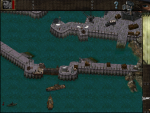I just checked some of the .VOL files to see about the mirroring and all, but I actually couldn't find any at first glance.
But with respect to the overlaying of those tiles, this is an excerpt of one of those .VOL files:
TILE 1894,1553, 79, 318,1903, 519, 0,"MAR0DST.BMP"," "
TILE 1973,1594, 79, 339,1981, 560, 0,"MAR0DST.BMP"," "
TILE 2052,1639, 79, 328,2060, 603, 0,"MAR0DST.BMP"," "
TILE 2131,1690, 79, 313,2138, 653, 0,"MAR0DST.BMP"," "
TILE 2210,1738, 79, 306,2216, 702, 0,"MAR0DST.BMP"," "
TILE 2289,1782, 79, 310,2295, 746, 0,"MAR0DST.BMP"," "
Since the tile is 256x256 pixels, these coordinates are not bordering eachother, but actually partially overlapping one another. This gives a semi-random feel and look to the water, especially since the color variations are also subtle - and moreover, the function that governs motion applies to them all and causes all of them to move, bob and wave, making it even harder to see where they overlap. However, by this overlapping you will not see a global pattern at regular intervals in the water; the human eye is somewhat sensitive to such patterns, hence this overlapping disrupts that effect.
If you look very closely when in a mission, you can identify various tiles ... but during normal, regular gameplay you won't notice it, mostly because the water is just backdrop, not the center of your focus and attention.

















